Jira is more than just a task tracker; it’s the engine of your team’s productivity. Yet, many teams barely scratch the surface, sticking to out-of-the-box settings that create friction rather than flow. The difference between a good team and a great one often lies in the sophistication of their processes. A well-designed workflow automates handoffs, enforces best practices, and provides crystal-clear visibility into project progress.
This guide moves beyond generic templates to provide a strategic blueprint for various team functions. We will explore a curated collection of sample Jira workflows designed for software development, IT support, marketing, and more. For distributed teams, mastering these processes is a cornerstone of effective Remote Project Management Tools, enabling them to maintain alignment and achieve peak performance.
Each example includes a detailed breakdown, strategic analysis, and actionable takeaways to help you adapt these concepts for your own use. You’ll see exactly how to implement specific statuses, transitions, and automations, complete with screenshots and direct links to the source. Prepare to transform your Jira instance from a simple to-do list into a powerful, customized productivity machine that accelerates delivery and enhances collaboration across your entire organization.
1. 7 Jira Workflow Examples to Boost Team Efficiency in 2025
Website: resolution Reichert Network Solutions GmbH
Resolution’s guide, “7 Jira Workflow Examples to Boost Team Efficiency in 2025,” earns its place as our featured choice for its exceptional depth and strategic focus. It moves beyond simple diagrams, positioning Jira workflows as powerful strategic assets for organizational efficiency. This resource provides a masterclass in transforming a standard Jira setup into a finely tuned engine for productivity, making it an indispensable read for Jira administrators, project managers, and team leads aiming for operational excellence.
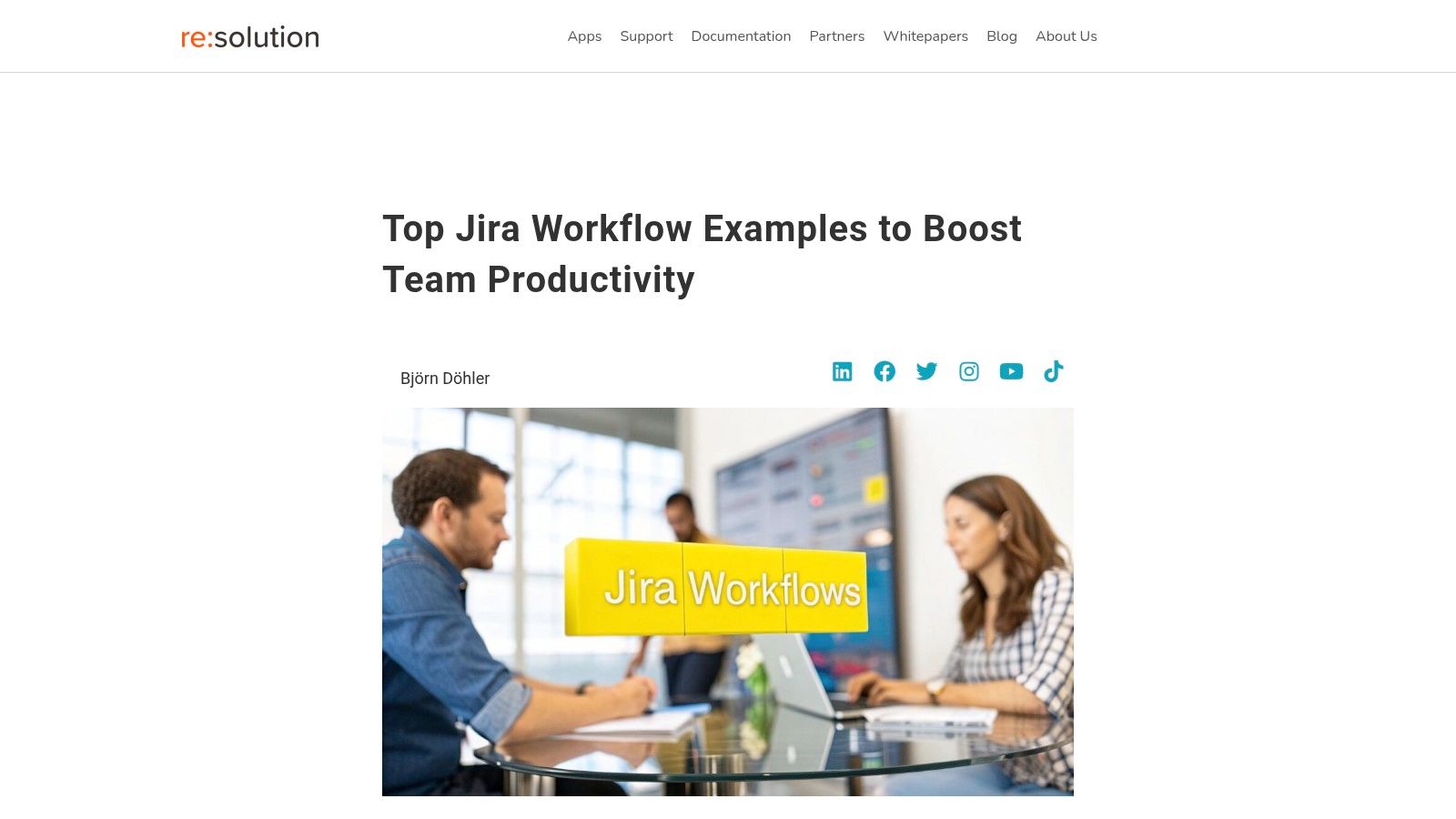
The guide’s standout quality is its comprehensive, multi-departmental approach. It doesn’t just cater to software developers; it provides meticulously crafted sample jira workflows for a wide array of business functions. This diversity is its core strength, offering actionable blueprints for teams in marketing, IT service management (ITSM), and even content publishing.
Strategic Analysis and Key Strengths
Resolution’s approach is rooted in practicality and strategic implementation. The article excels at breaking down not just the what but the why behind each workflow structure. Each example is presented with a clear rationale, detailing how specific statuses, transitions, and automations work together to solve common business problems.
Strategic Insight: The true value of a workflow isn’t its complexity but its clarity. Resolution’s examples emphasize creating transparent, predictable processes that minimize ambiguity and empower team members to understand their role in the larger project lifecycle.
Key advantages of their approach include:
- Diverse Use Cases: The guide provides tailored workflows for different teams, including a standard software development workflow, a marketing campaign process, and a bug-tracking lifecycle. This variety ensures its relevance across an entire organization.
- Actionable Blueprints: Each example serves as a ready-to-use template. The article provides the necessary detail for a Jira administrator to replicate the workflow, including specific statuses and transition logic.
- Focus on Automation: The analysis highlights opportunities to automate handoffs between stages, such as automatically assigning an issue to the QA team once it moves from “In Progress” to “Ready for Test.” This tactical advice helps teams eliminate manual bottlenecks.
Practical Tips for Implementation
To get the most out of this resource, don’t just copy and paste the examples. Instead, use them as a strategic foundation.
- Conduct a Workflow Audit: Before implementing a new design, map out your current process. Identify existing pain points, delays, and areas of confusion.
- Adapt, Don’t Just Adopt: Use the Resolution examples as a starting point. Meet with your team to customize the statuses and transitions to fit your unique operational needs and terminology.
- Iterate and Improve: A workflow is never truly finished. Implement your new process and gather feedback after a few sprints or project cycles. Use Jira’s reporting capabilities to identify areas for further optimization.
For those looking to explore even more configurations, Resolution offers an expanded guide. You can learn more about their additional Jira workflow examples here to further enhance your team’s processes. This guide is a premier free resource for any team serious about leveraging Jira to its full potential.
2. Atlassian’s Jira Templates
For those seeking reliable, out-of-the-box solutions, going directly to the source is often the best strategy. Atlassian’s own Jira Template library is the official, authoritative repository for pre-configured project setups. It stands out by guaranteeing seamless integration, compatibility, and ongoing support directly from the creators of Jira, eliminating the risks associated with third-party or community-built solutions. This makes it an ideal starting point for teams new to Jira or for experienced admins looking for a solid foundation to build upon.
These templates are more than just workflow diagrams; they are complete project blueprints. Each one comes with pre-configured issue types, custom fields, permissions, and board setups tailored to specific team functions. This holistic approach significantly accelerates project deployment, allowing teams to bypass tedious initial configurations and dive straight into their work.
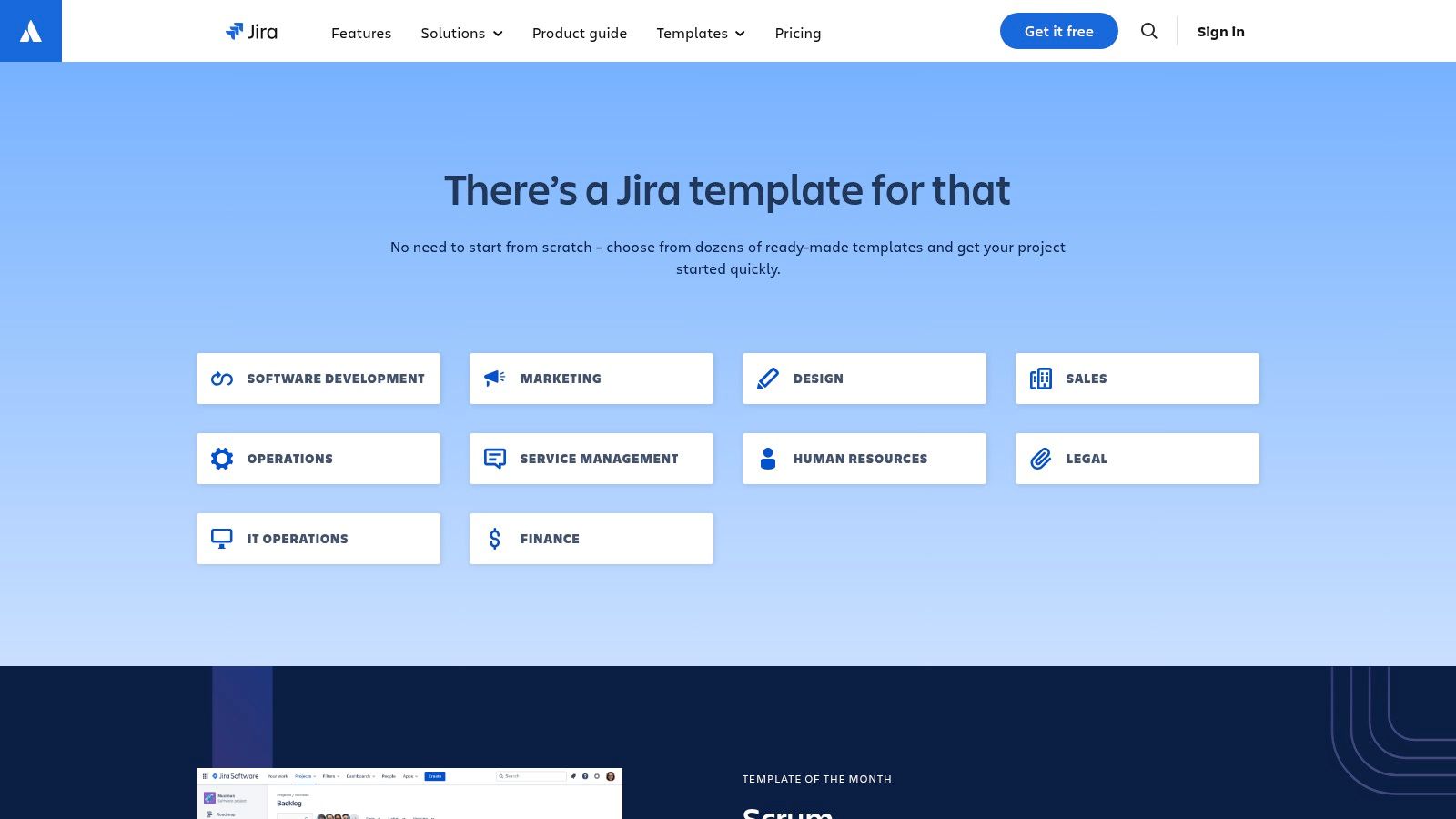
Strategic Analysis: Starting with a Solid Baseline
The core value of the Atlassian library is providing a trusted baseline. While a custom-built workflow might seem ideal, starting from a proven, Atlassian-vetted template ensures you’re incorporating best practices from the very beginning. This approach minimizes the risk of creating inefficient or broken processes.
Key Insight: Atlassian’s templates serve as excellent sample Jira workflows because they are built on data and feedback from thousands of teams. Using them allows you to leverage collective industry wisdom without extensive research.
Actionable Takeaways & Unique Offerings
- Diverse Selection: The library offers a broad range of templates, from “Kanban” and “Scrum” for software teams to specialized setups for Marketing, HR, Finance, and Legal. This diversity makes it a one-stop-shop for organizations standardizing on Jira across different departments.
- Access & Cost: The templates are completely free for all Jira users (Cloud and Data Center). They are accessible directly within Jira when you create a new project, making the user experience incredibly smooth.
- Practical Tip: Always preview a template before implementing it. Use the preview to assess its statuses, transitions, and issue types. Consider it a starting point, not a final product, and plan to make minor tweaks to align it perfectly with your team’s specific processes.
While these templates offer less flexibility than building a workflow from scratch, their reliability and ease of use provide an unmatched advantage for rapid and effective project setup.
Website: https://www.atlassian.com/software/jira/templates
3. Strategy for Jira® – Jira Workflow Examples
For Jira administrators who want to move beyond basic templates and understand the “why” behind workflow design, Strategy for Jira® offers a unique, documentation-focused approach. Unlike platforms that just provide visual diagrams, this resource delivers a package of documented workflow examples and templates. This emphasis on documentation and best practices makes it an invaluable tool for admins tasked with creating, maintaining, and scaling complex Jira instances.
This platform shines by treating workflows not just as diagrams, but as critical business assets that require clear documentation for governance and training. It provides a structured method for planning and implementing processes, which is essential for ensuring long-term maintainability and consistency across an organization.
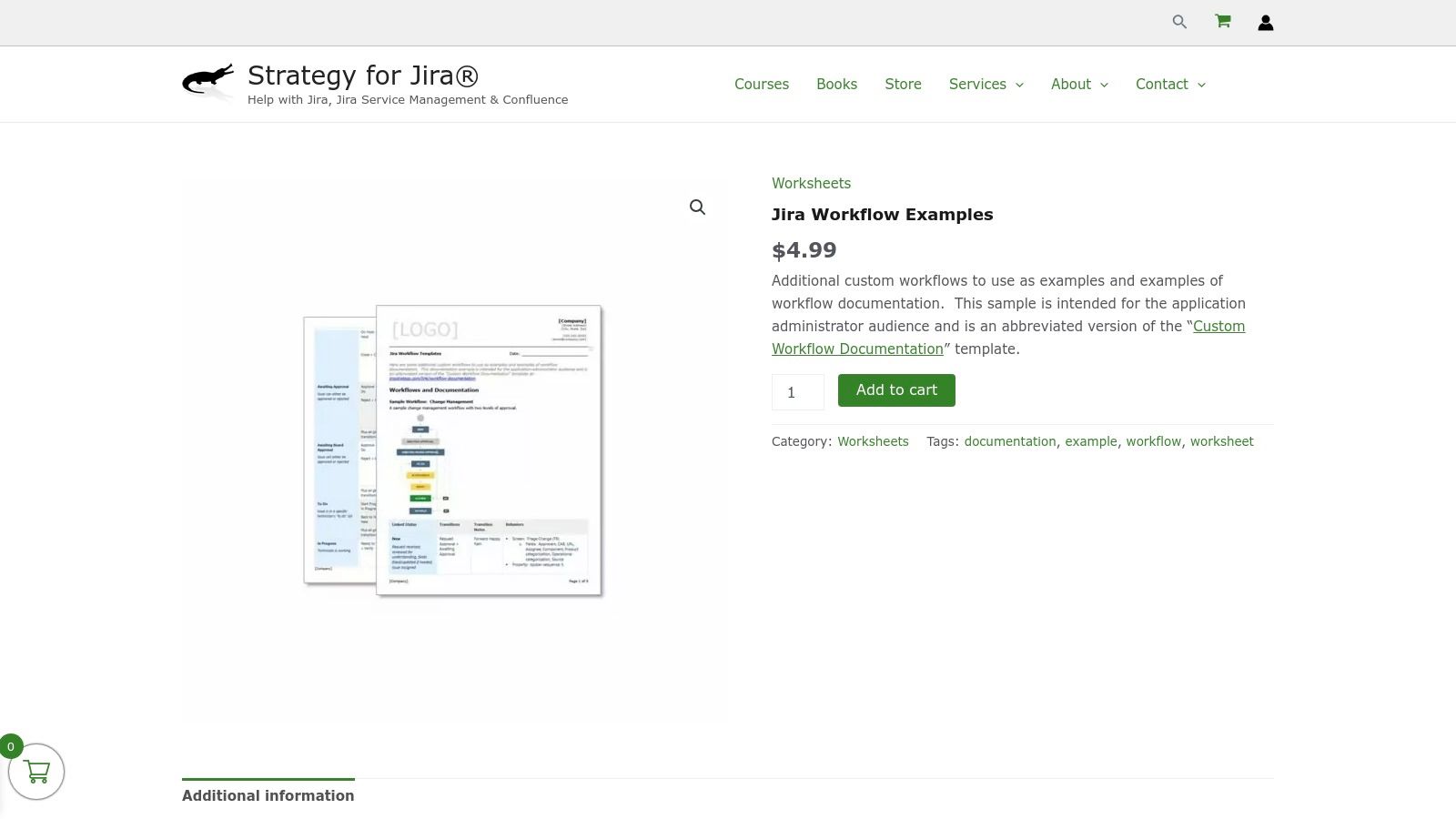
Strategic Analysis: Mastering the Administrative Side
The core value here is empowering the Jira administrator. While other resources focus on the end-user experience, Strategy for Jira® targets the architects of the system. It provides the tools to not only build a workflow but also to document it effectively, which is a critical step often overlooked. Proper documentation ensures that anyone can understand the purpose of different statuses, transitions, and rules, preventing configuration drift over time.
Key Insight: These sample Jira workflows are more than just examples; they are educational tools. By studying the included documentation, administrators learn how to think strategically about workflow design, considering aspects like user permissions, transition triggers, and post-functions.
Actionable Takeaways & Unique Offerings
- Documentation-First Approach: The standout feature is the inclusion of workflow documentation templates. This encourages admins to adopt best practices for managing their configurations, making systems easier to audit, troubleshoot, and hand over.
- Access & Cost: The entire package of examples and templates is available for a one-time purchase of $4.99. This makes it an extremely cost-effective way to access practical, real-world examples that go deeper than free, surface-level diagrams.
- Practical Tip: Use these examples as a blueprint for your own internal workflow library. As you build or modify workflows for different teams, use the provided templates to document each one. This creates a standardized, internal knowledge base that will save significant time on training and future administration.
Although the examples must be implemented manually and the selection is more curated than exhaustive, the focus on administrative best practices provides a unique and powerful advantage for serious Jira managers.
Website: https://www.jirastrategy.com/product/jira-workflow-examples/
4. Atlassian’s Jira Automation Template Library
An efficient workflow is not just about the states and transitions; it’s about the automated actions that power it behind the scenes. Atlassian’s Jira Automation Template Library is a powerful resource dedicated to this principle. It provides hundreds of pre-built automation rules designed to handle repetitive tasks, enforce processes, and integrate with other tools, effectively turning a static workflow into a dynamic, self-managing system. This library stands out by focusing on the operational efficiency within your existing workflow, rather than the workflow structure itself.
The templates are essentially plug-and-play recipes for common Jira scenarios. From auto-assigning issues to syncing parent and sub-task statuses, these rules eliminate manual work and reduce the potential for human error. This focus on automation makes it a critical companion resource for anyone designing or optimizing a Jira project, ensuring the resulting processes are not only well-structured but also highly efficient.
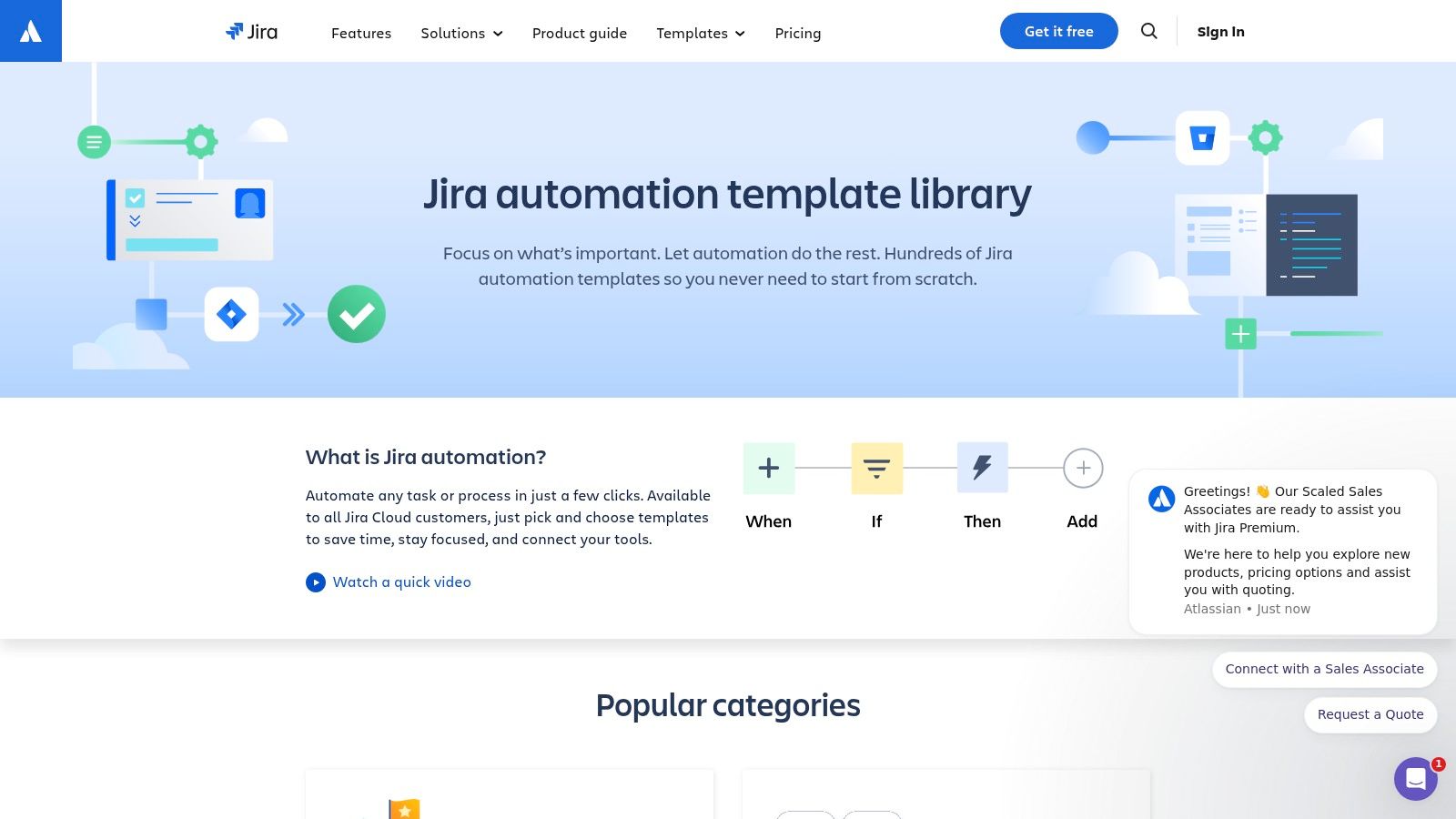
Strategic Analysis: Automating Your Workflow Logic
The true power of this library lies in its ability to bring your workflow’s logic to life. A diagram can define that a “To Do” ticket moves to “In Progress,” but an automation rule can ensure that upon this transition, the ticket is automatically assigned to the person who initiated the move. This elevates your setup from a simple tracking board to an intelligent, automated process.
Key Insight: These automations are themselves powerful sample Jira workflows for specific actions. By combining several automation templates, you can construct sophisticated, hands-off processes that keep teams aligned and projects moving forward with minimal administrative overhead.
Actionable Takeaways & Unique Offerings
- Broad Use Cases: The library covers a vast range of needs, including rules for DevOps (e.g., auto-commenting on a ticket when a Bitbucket build fails), ITSM (e.g., closing a request when a linked incident is resolved), and agile project management (e.g., moving an epic to “Done” when all its stories are complete). Explore the different categories to discover a variety of workflow automation solutions.
- Access & Cost: The automation template library is free and built directly into Jira Cloud projects. You can access it via Project Settings > Automation, making it incredibly easy to find and implement rules.
- Practical Tip: Start small by implementing one or two simple rules, like auto-closing stale tickets or notifying a Slack channel when a high-priority bug is created. Monitor their impact to understand the value before building more complex, multi-step automations.
While some templates may require minor customization to fit your exact needs, their direct integration and focus on efficiency make them an indispensable tool for any serious Jira administrator.
Website: https://www.atlassian.com/software/jira/automation-template-library
5. Warsaw Dynamics – Jira Project Templates
While many resources offer downloadable templates, Warsaw Dynamics provides something different yet equally valuable: a strategic blueprint. Their informational guide delves into the “why” behind various Jira project templates, serving as an educational resource rather than a direct-download repository. This platform is perfect for teams who want to understand the foundational logic of a workflow before committing to building or implementing one.
This approach is particularly useful for Jira administrators and project managers tasked with choosing the right starting point for their teams. Instead of blindly adopting a template, they can use this guide to make an informed decision, ensuring the selected framework aligns with their team’s unique operational needs, communication style, and long-term goals.
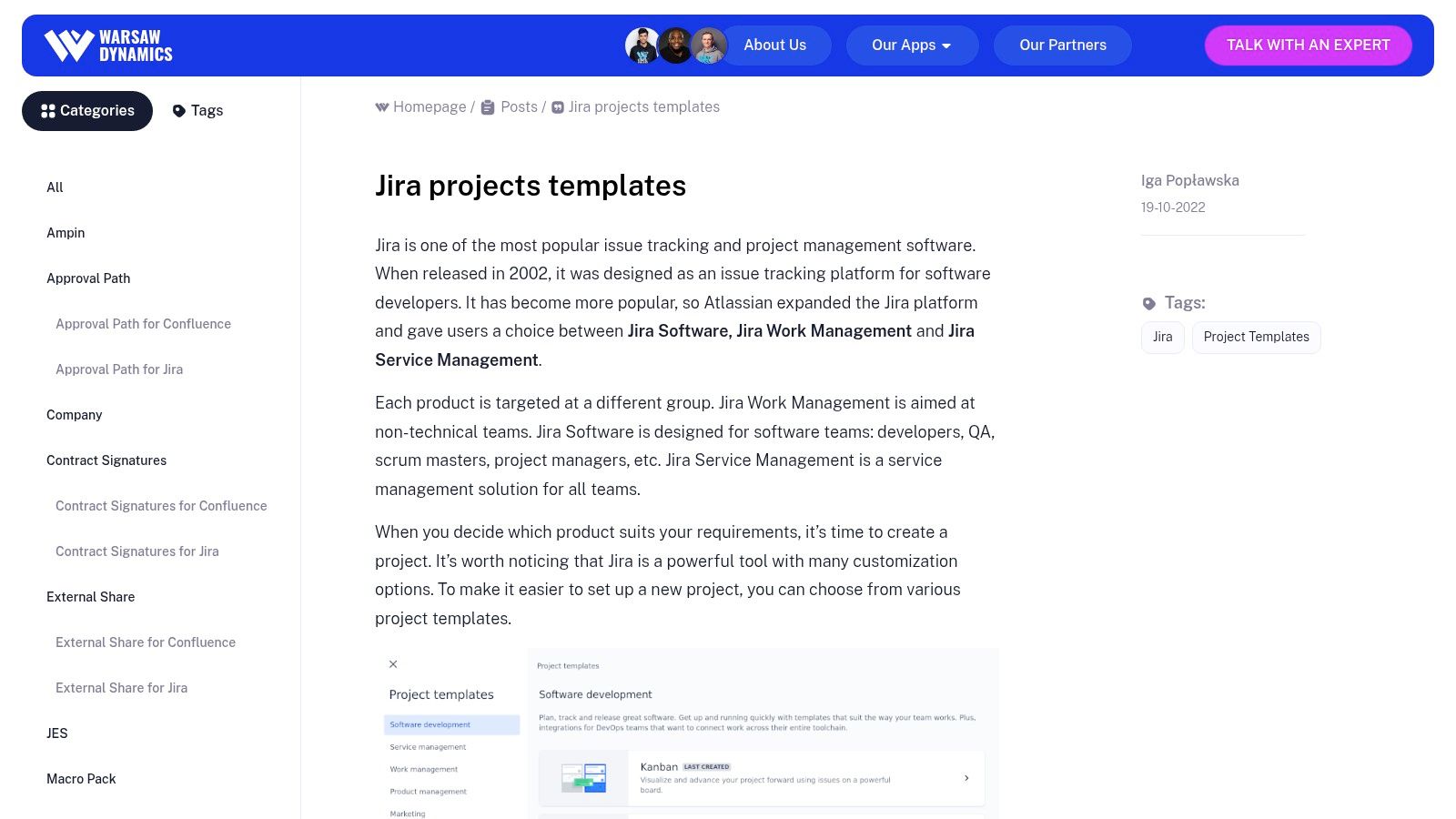
Strategic Analysis: Building with Intent
The primary value of Warsaw Dynamics is in its educational clarity. It prevents teams from falling into the common trap of choosing a popular but ill-fitting template. By detailing the intended use cases, standard issue types, and typical workflow statuses for different project types, it equips users to build their own systems with purpose and precision.
Key Insight: This resource provides the critical “pre-work” for creating effective sample Jira workflows. Understanding the theory and best practices behind a template’s structure is the first step toward successful customization and adoption.
Actionable Takeaways & Unique Offerings
- Informed Selection: The guide breaks down various templates, such as those for software development, project management, and process management. This helps you match your team’s function (e.g., bug tracking vs. task management) to the right foundational structure.
- Access & Cost: The information is presented in a detailed blog post that is completely free and accessible to anyone without registration. It acts as an open-knowledge base for the Jira community.
- Practical Tip: Use this guide as a reference during your team’s initial Jira planning session. Before creating a project in Jira, review the relevant template description on Warsaw Dynamics to align on issue types and statuses. This ensures everyone understands the “why” behind your chosen workflow from day one.
While you cannot download anything directly, the intellectual capital gained from this resource is invaluable. It empowers you to build a better, more thoughtful workflow from scratch or intelligently modify an existing one, leading to higher team adoption and efficiency.
Website: https://warsawdynamics.com/posts/jira-project-templates/
6. Adaptavist – Workflow Steps for Jira Templates
For teams deeply embedded in a chat-ops culture, Adaptavist’s Workflow Steps for Jira templates offer a powerful way to bridge the gap between communication and project management. Their unique value lies in integrating Jira directly with Slack, enabling automated workflows that trigger from and report back to your primary communication hub. This focus on cross-tool automation distinguishes Adaptavist from others, as it’s designed specifically to reduce context switching and keep teams moving fast within the tools they already use daily.
These templates provide pre-configured automation rules that connect Slack actions to Jira workflows. For example, a team member can create a bug report, request a new feature, or add an item to the backlog by simply using a command or an emoji reaction in a designated Slack channel. This approach streamlines routine tasks, making Jira more accessible and less of an interruption to the natural flow of conversation and collaboration.
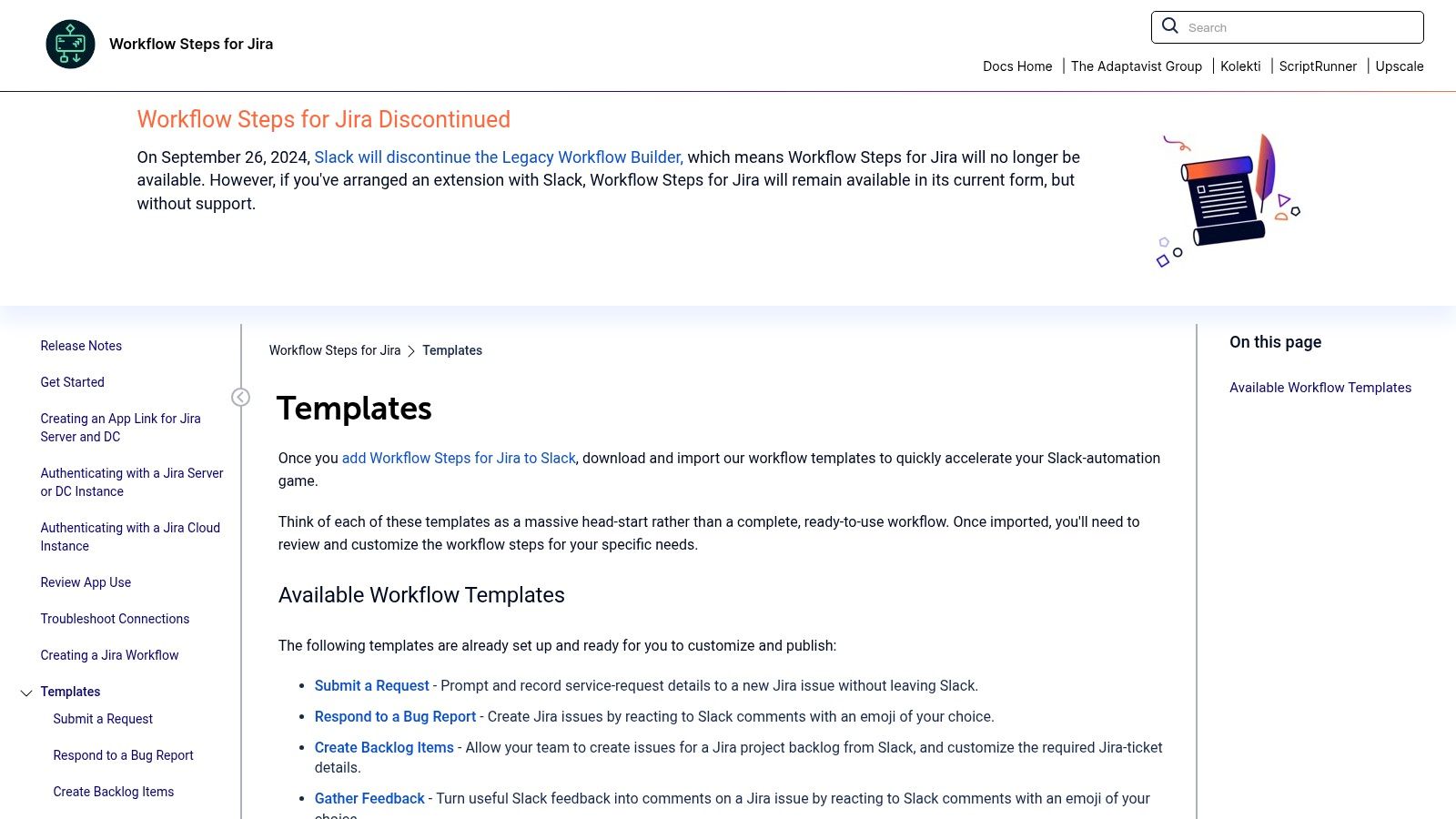
Strategic Analysis: Automating from Your Communication Hub
The core strategy here is to bring the workflow to the user, not the other way around. By initiating Jira processes from Slack, teams can capture important tasks and issues at the moment they arise, without needing to open a new tab, log in, find the right project, and fill out a form. This dramatically lowers the barrier to entry for logging work and ensures critical information isn’t lost in conversation.
Key Insight: Adaptavist’s templates provide excellent sample Jira workflows for teams practicing chat-ops. They demonstrate how to build a process that enhances existing communication habits rather than forcing users to adopt a completely separate, disruptive process.
Actionable Takeaways & Unique Offerings
- Slack-Centric Automation: The templates are built around common Slack interactions. Examples include creating a Jira issue from a Slack message, requesting approvals, and automatically posting issue status updates back into a channel.
- Access & Cost: The workflow templates are free to download from the Adaptavist documentation site. However, implementing them requires having the “Workflow Steps for Jira” app from the Atlassian Marketplace, as well as active Jira and Slack accounts.
- Practical Tip: Start with a single, high-impact automation, like “Create a bug report from a 🐛 emoji reaction” in your team’s main channel. Perfecting this one process will demonstrate immediate value and build momentum for adopting more complex automations. This approach helps in understanding how to improve workflow efficiency by minimizing friction.
While the initial setup might require some technical comfort with connecting apps, the long-term benefit of a seamlessly integrated Jira-Slack environment is a significant boost to productivity and team collaboration.
Website: https://docs.adaptavist.com/ws4j/latest/templates
7. Atlassian Community – Submit Your Jira Workflow
For advanced users and innovators, the Atlassian Community submission platform offers a unique opportunity to move from being a consumer of workflows to a creator. This initiative allows experienced Jira admins and process engineers to share their custom-built workflows with a global audience. It’s a space driven by real-world application, showcasing solutions born from the specific, nuanced challenges that teams face every day.
This platform stands out by crowdsourcing innovation. Instead of relying solely on officially sanctioned templates, it opens the door to a vast repository of user-generated designs. This provides access to highly specialized and creative solutions that might not exist in any official library, reflecting the true flexibility of Jira when pushed to its limits by its most dedicated users.
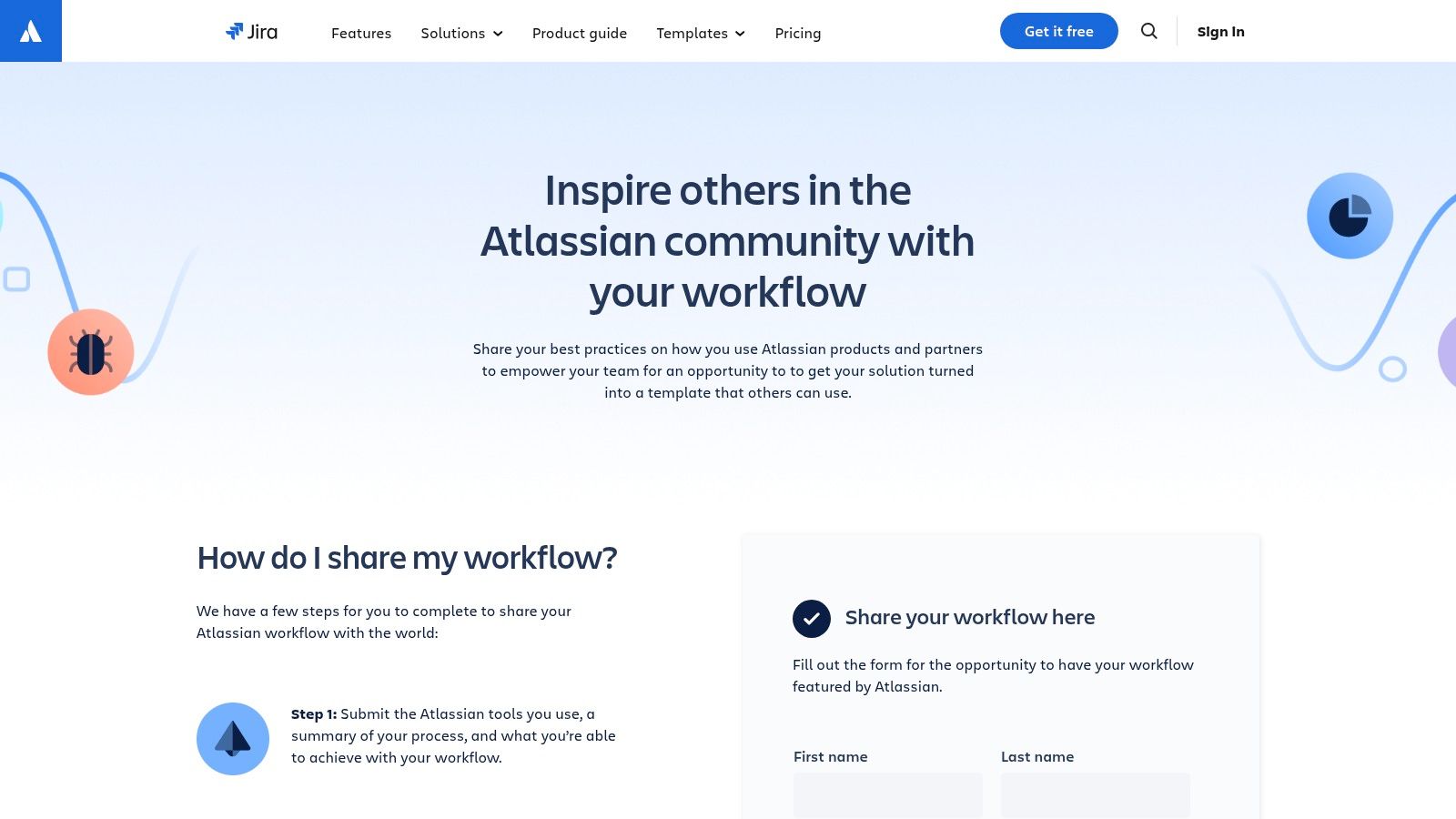
Strategic Analysis: Tapping into Grassroots Innovation
The primary value here is accessing battle-tested workflows from peers. While official templates are built for broad appeal, community submissions are often hyper-specific, solving niche problems with elegant and efficient processes. Exploring these submissions can expose you to new ways of thinking about workflow design and state management that you might not have considered.
Key Insight: The Atlassian Community platform provides some of the most authentic sample Jira workflows because they are crafted by practitioners to solve real-world problems. This is where you find inspiration for complex, non-standard operational needs.
Actionable Takeaways & Unique Offerings
- Discover Niche Solutions: This is the best place to find workflows for unconventional use cases, like managing a video production pipeline, tracking academic research, or coordinating multi-stage client onboarding. The diversity is unparalleled.
- Access & Cost: The platform is completely free to use. You can both browse submissions and submit your own without any cost. However, be aware that submitted workflows are subject to a review process by Atlassian, and not all are accepted or featured.
- Gain Recognition: For those who contribute, it’s an excellent way to build a professional reputation within the Atlassian ecosystem. Having a workflow accepted and potentially featured as a template is a significant community achievement.
- Practical Tip: When browsing, pay close attention to the problem statement accompanying each workflow. Since these are user-generated, understanding the original context is crucial to determining if the solution is a good fit for your team’s needs.
While the quality can vary and acceptance isn’t guaranteed, this community hub is an invaluable resource for discovering truly innovative and practical workflow designs straight from the trenches.
Website: https://www.atlassian.com/software/jira/templatesubmission
Comparison of 7 Sample Jira Workflows
| Resource Title | 🔄 Implementation Complexity | 💡 Resource Requirements | 📊 Expected Outcomes | 💡 Ideal Use Cases | ⭐ Key Advantages |
|---|---|---|---|---|---|
| 7 Jira Workflow Examples to Boost Team Efficiency in 2025 | Moderate – requires some customization | Jira users familiar with workflows | Clear, transparent processes; reduced bottlenecks | Teams seeking to enhance collaboration & accelerate delivery | Diverse templates; strategic analysis; ready for immediate use |
| Atlassian’s Jira Templates | Low – pre-configured templates | Jira users; free access | Quick project setup with optimized workflows | Users needing fast, reliable workflow setups | Official, regularly updated; seamless Atlassian integration |
| Strategy for Jira® – Jira Workflow Examples | Moderate – manual implementation needed | Jira administrators; small cost ($4.99) | Improved workflow configurations | Jira admins aiming for practical workflow customization | Cost-effective; real-world examples; documentation included |
| Atlassian’s Jira Automation Template Library | Moderate – primarily Jira Cloud users | Jira Cloud subscription | Automated tasks; increased consistency and speed | Teams focused on automating repetitive Jira workflows | Extensive templates; integration with multiple tools |
| Warsaw Dynamics – Jira Project Templates | Low – informational, manual implementation | Anyone interested in Jira templates | Better understanding; informed template choices | Teams researching suitable project templates | Free access; detailed template insights |
| Adaptavist – Workflow Steps for Jira Templates | Moderate to High – setup and integration needed | Jira and Slack accounts; some technical skills | Improved collaboration; reduced tool-switching | Teams using Slack/Jira integration for automated workflows | Enhances Slack-Jira collaboration; free; customizable templates |
| Atlassian Community – Submit Your Jira Workflow | Variable – depends on workflow complexity | Jira users who contribute or browse workflows | Access to diverse workflows; community engagement | Users wanting to share or find innovative real-world solutions | Community-driven; wide variety; potential official recognition |
From Sample to System: Making These Workflows Your Own
We have journeyed through a diverse collection of seven powerful sample Jira workflows, from Atlassian’s foundational templates to specialized examples from Warsaw Dynamics and the collaborative submissions on the Atlassian Community. Each example serves not as a rigid blueprint, but as a strategic launchpad. The most crucial takeaway is that the ideal workflow is never a direct copy; it’s a customized system built upon a solid, relevant foundation.
The true value emerges when you move beyond mere imitation and begin the process of adaptation. Start by identifying the sample workflow that most closely mirrors your team’s existing processes, whether you’re a software development team using a complex branching model or a marketing team managing content from ideation to publication. Use this as your starting point for a conversation with your team.
Your Action Plan for Implementation
To transform a sample into a high-functioning system, follow these actionable steps:
- Select a Foundation: Choose the workflow from our list that best aligns with your team’s core function. Is it a simple “To Do, In Progress, Done” model, or do you need more granular stages like “Code Review,” “QA Testing,” or “Awaiting Customer Feedback”?
- Map Your Reality: Before touching Jira, whiteboard your team’s actual process. Identify every step a task takes from creation to completion. This real-world map is your guide for customization.
- Customize with Precision: Now, enter Jira and begin modifying your chosen template. Don’t hesitate to add, rename, or remove statuses. A status like “Blocked” or “On Hold” can provide critical visibility that many basic templates lack. The goal is to create a digital reflection of your team’s unique operational reality.
- Integrate and Automate: This is where you elevate your workflow from a simple task tracker to a strategic asset. Consider the data that exists outside of Jira. For instance, customer support tickets or sales-qualified leads often contain context vital for development or product teams.
Strategic Insight: A workflow’s power multiplies when it’s connected to other core business systems. Integrating customer data directly into Jira issues eliminates context switching and ensures teams are working on tasks that have a measurable impact on customer satisfaction and revenue.
Final Thoughts on Your Workflow Journey
Implementing one of these sample Jira workflows is just the beginning. The most successful teams treat their Jira configuration as a living system, one that is reviewed and refined quarterly or biannually. As your team evolves, so too should its processes.
By thoughtfully selecting a base, customizing it to your specific needs, and enriching it with cross-platform data, you transform Jira from a project management tool into the central nervous system of your team’s operations. This strategic approach is what drives real efficiency, fosters seamless collaboration, and ultimately delivers tangible business results.
Ready to bridge the gap between your customer-facing teams and your development process? The HubSpot for Jira integration by resolution Reichert Network Solutions GmbH embeds crucial customer data directly into your Jira issues. Empower your team to build better products by giving them the context they need, right where they work.
